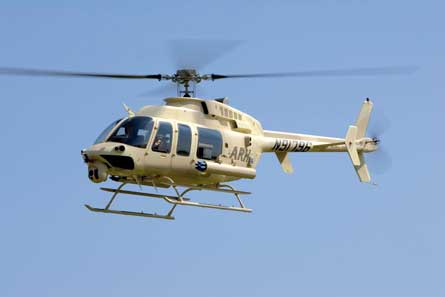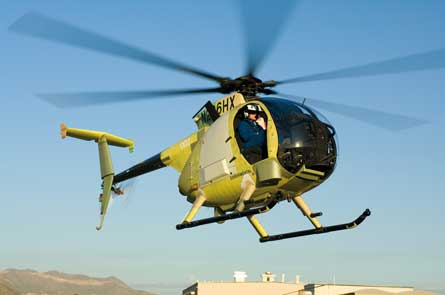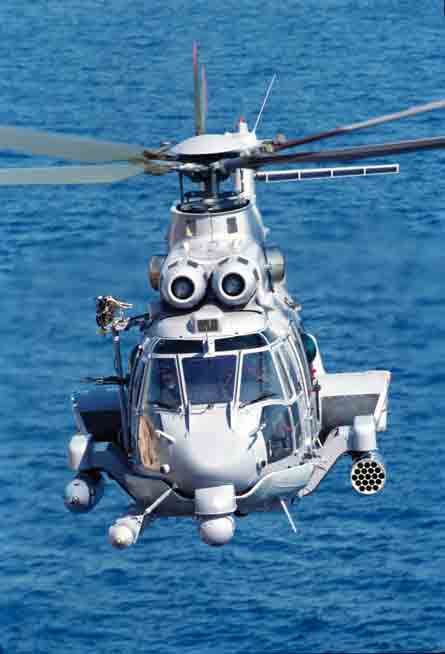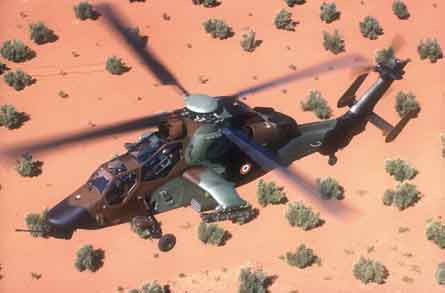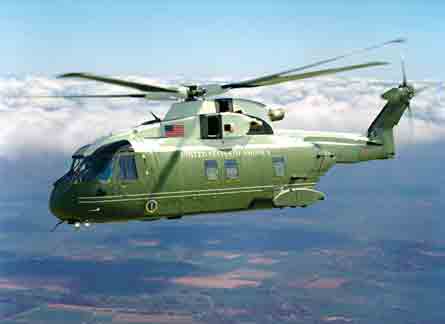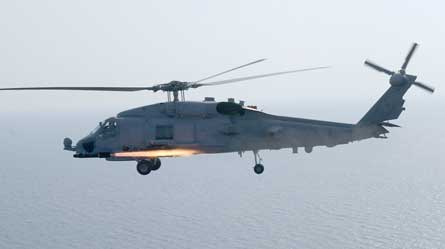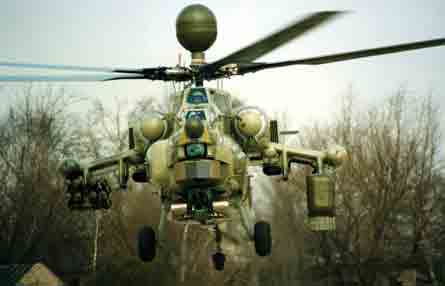Business is booming for the world's helicopter manufacturers, with global deliveries over the next 10 years predicted to top $81 billion
With foreign wars and natural disasters bolstering demand for military and paramilitary rotorcraft, manufacturers are enjoying their healthiest business for several decades. In Europe, a new generation of helicopters is entering volume production in the USA, modernisation is extending the production horizons for major programmes and in Russia, exports of established designs is keeping the industry afloat as it struggles to bring a new generation of machines to market.
Earlier this year, engine manufacturer Rolls-Royce forecast deliveries of almost 5,170 new military helicopters over the 10-year period 2006-15, plus another 560 major upgrades, valued at more than $81 billion. The company projected an average annual growth in deliveries of just under 5% a year to the end of the decade, as military fleets are replenished. More recently, analyst Frost & Sullivan forecast a European military helicopter market worth $26 billion between 2006 and 2015.
|
|---|
Future Lynx uses systems from the Super lynx 300 |
Greater demands
The demands of operations in Afghanistan and Iraq, as well as those on the aftermath of the 2004 Indian Oceantsunami and 2005 Pakistan earthquake, while underlining the flexibility of helicopters, have emphasised the need for greater mission adaptability and load carrying capacity, Frost says. This is reflected in a surge of international interest in medium and heavy transport helicopters, like the AgustaWestland EH101, Boeing CH-47, NH Industries NH90 and Sikorsky UH-60, that can be reconfigured for humanitarian and reconstruction roles.
In the USA, the remaining major helicopter competitions are the US Air Force's 141-aircraft CSAR-X combat search-and-rescue requirement - for which the Boeing HH-47, Lockheed Martin US101 and Sikorsky HH-92 are candidates - and the follow-on 66-aircraft Common Vertical Lift Support Programme. But there are also major helicopter requirements in India, Pakistan, Saudi Arabia and elsewhere.
AGUSTAWESTLAND
Finmeccanica-owned AgustaWestland has announced plans to develop the AW149 multi-role battlefield helicopter, a derivative of its AW139 commercial medium twin. With a 7.5t maximum take-off weight, the AW149 will be larger than the 6.4t AW139 and capable of carrying up to 15 fully equipped troops or a 3t payload. Two 2,000shp-class (1,500kW) turboshafts will drive an enlarged main rotor, providing a 160kt (296km/h) cruise speed, 925km (500nm) range and hover out of ground effect at 6,000ft/95°F (1,830m/35°C).
AgustaWestland's UK arm is leading development of the AW149, with a first flight planned for 2009 and deliveries for 2011. The helicopter will have an open-systems avionics architecture with large flat-panel cockpit displays, digital four-axis automatic flight controls and integrated health and usage monitoring. Military features will include crashworthy self-sealing fuel tanks, heavy-duty landing gear and optional rotor de-icing, defence aids and weapon systems.
Defence sales accounted for 85% of AgustaWestland's €2.49 billion in revenues last year. The UK is a major market, with the signing in June of a £1 billion contract for 70 remanufactured Future Lynx helicopters for the British Army and Royal Navy. The upgrade will provide a common marinised airframe with crashworthy landing gear, new four-blade tail rotor and twin 1,360shp LHTEC CTS800-4 turboshafts, allowing in-service growth from 5,779kg to 6,250kg maximum all-up weight.
First flight is scheduled for late 2009, with delivery of 40 helicopters to the army and 30 to the navy beginning in 2011. The upgrade includes flat-panel cockpit displays, new tactical processor, integrated defensive aids and health and usage monitoring, engine infrared suppression, crashworthy seats and "role-fit" equipment.
The UK's Merlin capability sustainment programme, meanwhile, is driving upgrades to the medium/heavy triple-turbine EH101. Flight testing of improved "BERP IV" main rotor blades, uprated 2,530shp General Electric CT7-8E engines and integrated cockpit displays began in September, in support of Lockheed Martin's US101 programme, and a quadruplex-redundant, electrically actuated digital flight control system is under development.
AgustaWestland's A129 is one of two finalists in Turkey's competition for up to 50 attack helicopters, with the company offering to form a joint venture with Tusas Aerospace Industries to develop an upgraded version based on the LHTEC T800-powered A129 International and transfer production to Turkey.
|
|---|
Bell's ARH-70A armed scout is in flight test |
BELL BOEING
Operational deployment of the US Marine Corps' MV-22B Osprey is scheduled for next year, and the Bell Boeing joint venture is negotiating for the multi-year procurement of up to 185 aircraft over five years - with the goal of driving the tiltrotor's unit cost down to $58 million. A contract is targeted for award in mid-2007, with production planned to ramp up to 35 aircraft a year by 2011.
|
|---|
Boeing is seeking customers for the manned/unmanned A/MH-6 |
Special operations
Deliveries of combat-ready USMC Block B MV-22s began in December 2005. The first combat-configured Block 10 CV-22 was delivered to the US Air Force in March, and this special-operations variant is scheduled to enter service in 2009. The USMC plans to buy 360 MV-22s and the USAF 50 CV-22s, while the US Navy has an unfunded requirement for 48 V-22s.
Bell believes US Air Force Special Operations Command could require an additional 27 V-22s and the US Army a potential 25-75 aircraft to upgrade its special-operations fleet in the long term. The company identifies Israel, Japan and the UK as the first potential V-22 export customers, possibly in the 2011 timeframe.
BELL HELICOPTER
Flight tests of the ARH-70A armed reconnaissance helicopter (ARH) for the US Army began in July. The aircraft is a derivative of Bell's Model 407 light commercial helicopter, powered by a 970shp Honeywell HTS900-2 turboshaft. The US Army plans to buy 368 ARHs at an average of $5.5 million per aircraft to replace its OH-58B Kiowa Warriors, and the National Guard may buy another 120.
The ARH programme is running about a year behind the schedule set when the 36-month development contract was awarded in August 2005. The goal to have the first 30-aircraft unit equipped by October 2008 has slipped to July 2009. Bell is projecting production ramping up to just under 50 a year by 2010.
Bell's H-1 upgrade programme for the US Marine Corps is on a recovery path, meanwhile, after schedule delays and soaring costs. The first production modernised AH-1Z attack and UH-1Y utility helicopters were rolled out in September, but the programme has been restructured to delay initial operational capability for the remanufactured AH-1Z to 2011.
IOC for the more urgently needed UH-1Y is planned for September 2008, and all but the first few of the 100 aircraft planned will have new-build airframes - to avoid having to take a UH-1N out of service for remanufacture. Plans still call for 180 AH-1Ws to be remanufactured to Z standard. Bell identifies Malaysia and Taiwan as potential customers for theAH-Z and UH-1Y, which share a common tailboom, engines, rotor system, drive train and avionics architecture.
Bell is pursuing a 197-aircraft order from the Indian army for light reconnaissance helicopters, offering its Model 407 in competition with Eurocopter's AS550, with around 130 machines to be assembled in country by Hindustan Aeronautics. The US manufacturer delivered its 100th Huey II in July, and is targeting further sales of the UH-1H upgrade to Argentina, Brazil, Colombia and Ecuador.
BOEING
A $619 million contract for development of the Block III upgrade of US Army Boeing AH-64D Apache Longbows was signed in July, about two years later than planned. Deliveries of the modernised helicopter are to begin in 2011. Plans call for remanufacture of 284 Block I AH-64Ds, but ultimately the army's Block II Apaches will also be upgraded, possibly to a yet-to-be-define Block IV standard.
Block III upgrades the drive system with uprated 3,400shp face-gear transmission, General Electric T700-701D common engines and longer composite main rotor blades. Open-system avionics and other upgrades will increase situational awareness and survivability, enhance targeting, enable unmanned air-vehicle control and improve maintainability and training.
|
|---|
An upgraded Cougar, the EC725 entered service this year |
War replacement
Boeing completed US Army deliveries under the original 501-aircraft programme in August, but expects to remanufacture a further 96 AH-64As to D standard and build at least 27 new wartime-replacement aircraft. New AH-64Ds are being built for Greece and Kuwait, and 30 AH-64As are to be remanufactured to Ds for the Unite Arab Emirates, keeping the line open until Block III deliveries begin.
The first production CH-47F Chinook heavylift helicopter flew in October, with new-build airframe, Rockwell Collins Common Avionics Architecture System (CAAS) integrated flightdeck and BAE Systems digital automatic flight controls. US Army plans call for 513 modernised Chinooks - 452 CH-47Fs, including at least 55 new-build aircraft, and 61 special-operations MH-47Gs. Canada plans to buy 16 CH-47Fs and the Netherlands is negotiating for up to nine aircraft, and to upgrade its 11 CH-47Ds to F standard. India, Pakistan and Saudi Arabia are other prospects.
Boeing flew its light single-turbineA/MH-6X for the first time in September. The new-build helicopter combines the performance of the A/MH-6M Mission Enhanced Little Bird with the capabilities of the Unmanned Little Bird (ULB), a demonstrator based on a commercial MD Helicopters MH530F. The private-venture A/MH-6X "productionises" the ULB's capability to operate in both manned and unmanned modes.
CHINA
Internet pictures appearing to show China's new Changhe WZ-10 attack helicopter, still in flight test, reveal an aircraft resembling the Eurocopter Tiger, with stepped tandem seating, undernose 30mm cannon and stub wings for anti-armour missiles. Harbin, meanwhile, has teamed with Eurocopter on development of the Z-15, a 6t-class medium utility helicopter powered by two Pratt & Whitney Canada PT6s.
DENEL AVIATION
Turkey could decide the future of South Africa's helicopter industry, having shortlisted Denel's DSH-2 Rooivalk against the AgustaWestland A129 for its 50-aircraft attack requirement. Turkey's industry is being offered substantial involvement in upgrading and producing both helicopters, neither of which is in active production having failed to secure export customers. Denel delivered 16 Rooivalks to the South African Air Force, which would like to modernise its aircraft and acquire another 15.
EUROCOPTER
EADS North America was selected in June to supply the US Army's UH-72A light utility helicopter (LUH), based on Eurocopter's EC145 light commercial twin. The 322-aircraft contract, worth more than $2 billion, was challenged by two losing bidders, but in October the US Government Accountability Office threw out the protests, clearing the way for EADS to begin deliveries by year-end. Production of the LUH will be transferred to American Eurocopter's Columbus, Mississippi plant in phases, ramping up to more than 45 aircraft a year by 2008.
| |
|---|
Tigar production is ramping up at Eurocopter sites |
Eurocopter is the world's largest helicopter manufacturer, with a backlog of more than 1,000 civil, military and paramilitary orders and sales projected to increase from 390 aircraft this year to 400-500 annually for the next four to five years (Flight International, 31 October-6 November). An increasing proportion of sales are of dedicated military designs - the Tiger attack helicopter and naval/transport NH90.
But variants of Eurocopter's commercial helicopters continue to secure military customers, with Switzerland in April ordering 18 EC635 light twins for training and utility missions, plus two EC135 civil versions for VIP transport. Ruag will assemble 16 of the aircraft in Switzerland. The company is offering its AS550 for the 197-aircraft India light reconnaissance helicopter requirement and pursuing several opportunities for its medium/heavy EC725.
Eurocopter is increasing its involvement in international programmes, co-operating with Korea Aerospace Industry (KAI) on development of an 8t military transport under the Korean Helicopter Programme (KHP). The European manufacturer is also co-operating with China's AVIC II on developing the EC175, a 6t helicopter powered by two Pratt & Whitney Canada PT6s that is schedule to fly in 2009, with production in China and Europe planned to begin in 2011
Chasing exports
Launched in June, the $6-8 billion KHP calls for production of 245 helicopters for the South Korean army beginning in 2011, with a joint company to pursue the export market. GE's T700 has been selected to power the twin-turbine helicopter and Israel's Elbit Systems will integrate the mission system. Eurocopter has a stake of 30% in development and 20% in production, supplying the transmission and autopilot.
Spain will begin taking delivery of 24 Tiger HAD combat helicopters next year, armed with Israeli Rafael Spike-ER anti-armour missiles. Eurocopter's Spanish arm will assemble the Tiger, as well as most of the 45 NH90s Spain plans to buy and the 48 EC135s ordered earlier this year by the country's interior ministry.
|
|---|
First test VH-71A US Presidential helicopter will fly next year |
KAMAN
Efforts to market the SH-2G Super Seasprite maritime helicopter continue while Kaman works to complete the long-delayed SH-2G(A) development programme for the Royal Australian Navy. Mission system software qualification, and resolution of flight safety issues that resulted in grounding of the aircraft earlier this year, is near completion, the company says, but the Australian government is to decide this month whether to stay with the programme or seek an alternative.
LOCKHEED MARTIN
Under the $7 billion VXX US President helicopter programme won by the Lockheed Martin-led US101 team in January 2005, the first of five VH-71 test aircraft is in assembly at AgustaWestland and will be delivered to the prime contractor early next year. These will be followed by five UK-assembled Increment 1VH-71As and 18 Increment 2 VH-71Bs to be assembled by Bell Helicopter in Amarillo, Texas.
The Increment 1 helicopter is essentially the EH101 powered by 2,500shp GE CT7-8E engines. Increment 2 brings 3,000shp CT7-8E1s, combined with an uprated gearbox, improved BERP IV main rotor blades and a more-robust tailrotor. The Increment 2 aircraft will also have an all-metal, 10,000h-life airframe. Initial operational capability with the VH-71A is planned for 2009, but may slip into 2010.
NH INDUSTRIES
New Zealand's July order for nine NH90 medium transport helicopters took commitments for the multinational programme to 400 aircraft for 12 nations. The NH90, meanwhile, is on the verge of German type certification, clearing the way for entry into service after an 18-month delay (Flight International, 24-30 November).
Germany will receive the first three of 80 NH90s by year-end and Greece, with orders for 20, Finland with 20 and Sweden with 18 will also take delivery of their first aircraft. Deliveries from multiple assembly lines are expected to increase from 38 next year to 80 a year in 2010-11, with new orders for around 50 a year expected.
In June, Australia ordered 34 MRH-90 multi-role versions of the NH90, in addition to 12 ordered in 2005 for delivery beginning next year. All but the first four will be assembled by Eurocopter subsidiary Aerospace Australia. Contracts are pending with Belgium for 10 NH90s and with Spain for 45 - to be assembled by Eurocopter Spain.
Eurocopter holds 62.5% of NH Industries, AgustaWestland 32% and Stork Fokker 5.5%. The NH90 is being produced in tactical transport (TTH) and naval (NFH) versions, with assembly lines in France, Germany, Italy and at Patria in Finland as well as in Australia, and eventually Spain.
RUSSIA
The Russian helicopter industry is being consolidated under Oberonprom, a holding company 51% owned by the government that has stakes in the Kamov and Mil design bureau and the manufacturing plants, including Kazan Helicopters, Rostvertol and Ulan-Ude Aviation (UUAZ). With funding severely constraining development and production of new-generation helicopters, the industry is being sustained by sales of established military types.
Recent deals include the sale of 80 Kazan-built Mi-17-1Vs to India for delivery beginning in 2007 five Mi-17-V5s to Chile 10 UUAZ-built Mi-171Shs to Croatia, for delivery in 2007 and 20 Mi-17-V5s plus 10 Rostvertol-built Mi-33M attack and two Mi-26T heavylift helicopters to Venezuela. Ecuador plans to buy 18 Mi-17Shs. China is reportedly in talks to buy additional Kamov naval helicopters.
Rostvertol has begun production deliveries of the Mi-28N Night Hunter attack helicopter to the Russian armed forces, which plans to buy eight aircraft this year and up to 67 over the next nine years to replace Mi-24s. The Progress plant in Arsenyev has also been given the go-ahead to complete three Ka-50 Black Shark combat helicopters this year, and hopes to restart production of the two-seat Ka-52 Alligator.
In January, UUAZ was given the go-ahead to begin production of the Ka-62 medium helicopter, with the first of the 16-passenger, 6t-class utility machines to be completed in 2008 and production or 30-40 aircraft a year planned by 2010. Kazan is continuing development of the medium/heavy Mi-38, with production of 15.6t helicopter planned to begin in 2007, to replace the Mi-8 and Mi-17 beginning at the end of the decade.
SIKORSKY
|
|---|
Lockheed Martin is prime contractor, but Sikorsky builds the MH-60R |
The first production modernised UH-60M tactical transport was delivered to the US Army in July, with at least 1,200 new-build helicopters planned to replace existing Black Hawks. At the same time, Sikorsky plans to move production of the current UH-60L offshore to offer a lower-cost 10t helicopter as the International Black Hawk.
Seven of eight test UH-60Ms were remanufactured by Sikorsky, but beginning with the eighth aircraft the helicopters have new-build airframes. The M has a composite-spar, wide-chord main rotor blade and uprated GE T700-701D engines, providing additional lift capability, and Rockwell Collins CAAS integrated glass cockpit.
In September, Sikorsky signed a memorandum of understanding with PZL Mielec to assemble the International Black Hawk in Poland, with an agreement - which could include taking a stake in PZL - expected by year-end and deliveries to begin in 2010. The company has also introduced an Armed Black Hawk variant - either as a retrofit kit or new-build aircraft - that is aimed at export customers.
Sikorsky is producing the MH-60R multi-mission and MH-60S utility versions of the Seahawk naval helicopter, and developing the MH-92 military version of its S-92 medium helicopter for launch customer Canada.
|
|---|
After several years of development, the Mi-28N is in production |
Doubled payload
A testbed for the MH-92's fly-by-wire flight control system will fly in February, with delivery of the first of 28 Canadian aircraft - designated CH-148 Cyclones - scheduled for November 2008.
In January, Sikorsky was awarded a $3 billion contract to develop the heavylift CH-53K for the US Marine Corps, with production of 156 helicopters planned to replace CH-53Es. With an increased gross weight of 38.4t, the K will double the payload capability to 12,250kg over 205km. In addition to a new rotor system and Rockwell Collins integrated cockpit the K will have three more-powerful engines.
Source: Flight International






















